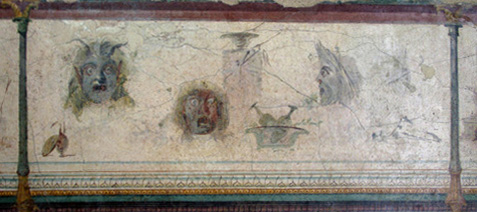 1>
1>Honour the Gods and appease the spirits of the dead
In-house shrines and paradise gardens collectively contributed to the concept of the house as sanctuary, but the most visible feature that established its sanctity was wall-painting. The way in which it achieved this was through the introduction of imagery that played a significant part in the daily spiritual life of the domus. The themes employed in the wall-paintings were many and varied, but in the final analysis they all interwove around the rubric: honour the Gods and appease the spirits of the dead. This objective was achieved by picturing metaphysical worlds that created an interplay between myth, magic, philosophy, superstition and religion, at the heart of which was a delicate balance between catharsis and tragedy based on the visualisation of divine beings, ancestor cults and states of apotheosis (figs.1). The person who made all of this visible within the house was the painter, his sophisticated understanding of the relationship between perspective and metaphysics and the ideo-spatial psychology associated with dissolution and becoming, made all of the above into a visual, albeit virtual, reality. He turned the house from a shack into a shrine. And yes, he painted portraits as well!
The Wall and its Simulacrum
In order to fully understand how the Roman House was transformed from a shack into a shrine, we need to carefully examine what happened in the transition between mock marble surfaces (First 'Incrustation' Style) and sophisticated spatial painting (Second 'Architectural' Style) (fig.2&3). In recent years there has been a tendency to gloss over the First style because of its lack of iconic references (Laidlaw 1985 is a notable exception). As a result, the astonishing conceptual transition that occurred between First and Second Style wall-painting has not been fully analysed. And yet, without the First Style’s uncompromising reiteration of the wall as a simulacrum of itself, later conceptual developments might not have occurred in the way that they did.
The wall in Roman wall-painting was not just a surface to paint on, nor was it a tabula rasa or blank canvas waiting to be filled by whatever the artist or patron desired, social and cultural decorum dictated otherwise. Even before a mark was made on the wall, these largely windowless surfaces were expected to characterise the household’s desire for protection, sanctity and prosperity. The First Style did this simply and effectively by making the wall appear as if made of large slabs of expensive marble. The accompanying psychological effect was a mixture of prosperity and security in a world that was often in political, if not economic, turmoil. The idea that wall-painting evolved in response to socio-political events taking place beyond the confines of the house is not as fanciful as it may seem at first glance. In La Peinture de Pompéi, 1991: 35-47, Schefold outlines some of the coincidences between political cause and socio-cultural effect in relation to the evolution of Roman wall-painting. Whatever the cause, the illusion of security and prosperity engendered by mock marble surfaces was something that the inhabitants universally desired.
The presence of eternity motifs pictured as though hanging on the faux marble wall, suggests that they wanted their security, prosperity and sanctity to last forever. This is evidenced by numerous images of fecundity garlands, eschatological masks, fillets or hanging scarves and eternity wreaths, all of which symbolised eternal union (fig.4&5). Earlier Macedonian Tombs such as the tomb of Lyson and Kallikles at Lefkadia used similar eternity symbols.
|